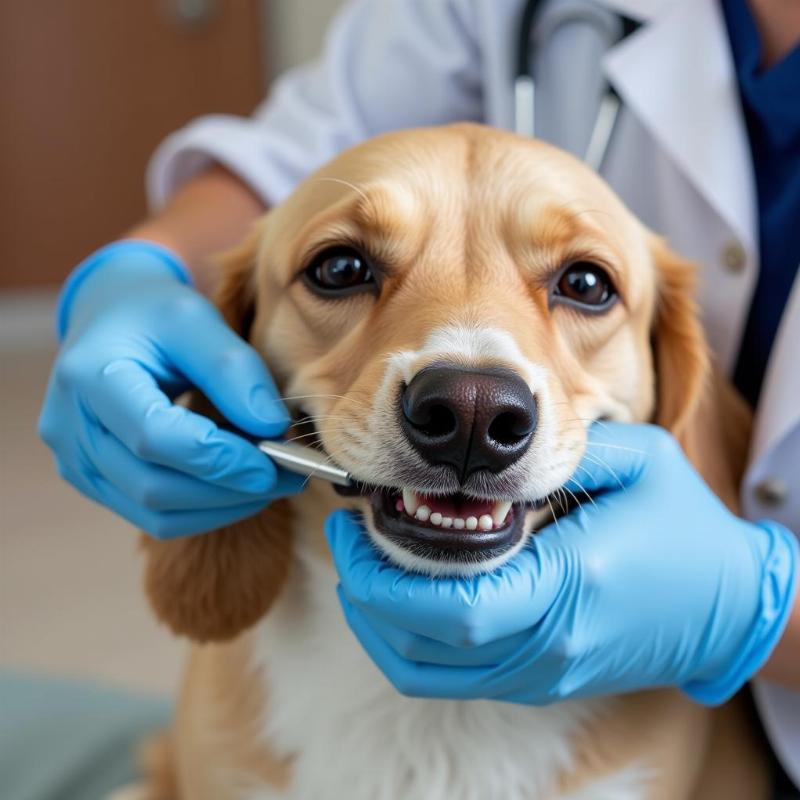Understanding oral tumors in dogs can be a daunting task for any pet parent. Searching for “pictures of oral tumors in dogs” often stems from a worried owner noticing something unusual in their dog’s mouth. This article will provide valuable information about identifying potential oral tumors in dogs, including what to look for and when to seek veterinary care. We’ll also discuss different types of oral tumors, common symptoms, and the importance of early detection.
Oral tumors are unfortunately a relatively common occurrence in dogs, especially in older dogs. While some oral growths may be benign, others can be malignant and require immediate veterinary attention. Being able to visually identify potential signs of oral tumors can be crucial for early diagnosis and treatment. It’s important to remember that only a veterinarian can definitively diagnose an oral tumor.
Identifying Potential Oral Tumors: What to Look For
Recognizing potential signs of oral tumors involves regularly examining your dog’s mouth. Look for any unusual lumps, bumps, swellings, or discolorations on the gums, tongue, lips, or roof of the mouth. Pay attention to any areas that bleed easily or seem to cause your dog discomfort.
Changes in your dog’s eating habits, such as difficulty chewing, dropping food, or excessive drooling, can also be indicators of an oral tumor. Bad breath, facial swelling, and reluctance to allow you to examine their mouth are other potential signs.
Types of Oral Tumors in Dogs
Several types of oral tumors can affect dogs. Some of the most common include melanomas, squamous cell carcinomas, fibrosarcomas, and epulides. Each type has different characteristics, growth rates, and treatment options.
Understanding Melanoma in Dogs
Melanoma is a type of cancer that can occur in various parts of the body, including the mouth. Oral melanomas in dogs are often pigmented (dark in color) but can also appear pink or unpigmented. They are typically highly aggressive and tend to spread quickly.
Squamous Cell Carcinoma: A Common Oral Tumor
Squamous cell carcinoma is the most common type of oral tumor in dogs. These tumors often appear as ulcerated masses or raised, cauliflower-like growths. They can be locally invasive and can spread to other parts of the body.
Fibrosarcoma: A Connective Tissue Tumor
Fibrosarcoma is a type of cancerous tumor that originates in the connective tissues of the mouth. These tumors can be locally aggressive and may recur after surgical removal.
When to Seek Veterinary Care
If you notice any unusual growths or changes in your dog’s mouth, it’s crucial to seek veterinary care promptly. Early detection and diagnosis are essential for effective treatment. Your veterinarian will perform a thorough oral examination and may recommend further diagnostic tests, such as biopsies, X-rays, or CT scans, to determine the nature of the growth.
 Dog Oral Tumor Examination
Dog Oral Tumor Examination
Conclusion: Prioritizing Your Dog’s Oral Health
Regularly checking your dog’s mouth and being aware of the potential signs of oral tumors are crucial for early detection and treatment. While finding any unusual growth can be concerning, remember that not all oral tumors are cancerous. However, prompt veterinary attention is essential for accurate diagnosis and the best possible outcome for your furry friend.
FAQ
- How often should I check my dog’s mouth? Ideally, you should check your dog’s mouth at least once a month.
- Are all oral tumors in dogs cancerous? No, some oral tumors are benign (non-cancerous), but only a veterinarian can determine this.
- What are the treatment options for oral tumors in dogs? Treatment options vary depending on the type and stage of the tumor and may include surgery, radiation therapy, chemotherapy, or a combination of these.
- Can diet affect the development of oral tumors in dogs? While a direct link between diet and oral tumors hasn’t been definitively established, a healthy diet contributes to overall health and well-being.
- What is the prognosis for dogs with oral tumors? The prognosis depends on various factors, including the type of tumor, its stage, and the dog’s overall health. Early detection and treatment generally improve the prognosis.
- Are certain breeds of dogs more prone to oral tumors? Yes, some breeds, such as Cocker Spaniels, German Shepherds, and Boxers, have a higher incidence of oral tumors.
- Can oral tumors be prevented in dogs? While there’s no guaranteed way to prevent oral tumors, regular oral hygiene and veterinary checkups can help with early detection.
Beautdogs.us is your trusted source for comprehensive dog care information. We offer expert advice on dog breeds, health, nutrition, and lifestyle. Whether you’re a new dog owner or a seasoned pet parent, Beautdogs.us provides reliable resources to help you give your canine companion the best possible care. Contact us today at [email protected] or +1 501-555-7529. Visit us online at Beautdogs.us for more information and expert tips on dog care.